A Weekly CoinWeek Column by Greg Reynolds
News and Analysis regarding scarce coins, coin markets, and the coin collecting community #114
This week, the firm of Stack’s-Bowers is conducting an auction at the Baltimore Convention Center. I viewed many of the lots. It turns out to be a much better and more important auction than I would have predicted that it would be, if I was asked three months ago. Unfortunately, it is not practical to write about all the desirable, classic U.S. coins in this auction. Furthermore, I do not wish to write only about the most valuable lots. People are interested in reading about a variety of coins, not just the most expensive ones. Further, collectors often like to read about collections not just about dealer consignments of expensive coins. So, I briefly provide an ‘idea’ of the auction event before I discuss patterns, nickels and dimes. Later, I mention some of the other coins in this sale.
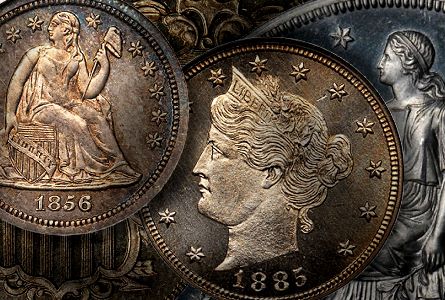 Bulk lots and various historical items will be auctioned tonight. During the day tomorrow, pre-federal coins will be sold before a hoard of both business strike and Proof Walking Liberty Half Dollars ‘go on the block.’ The consignment of a vast hoard of ‘late date’ business strike Walkers is not surprising. In general, business strikes minted after 1934 are extremely common. There are numerous large holdings. Hoards of Proofs are different matters, and are not common. Collectors of Proof Walkers may wish to take advantage of this offering.
Bulk lots and various historical items will be auctioned tonight. During the day tomorrow, pre-federal coins will be sold before a hoard of both business strike and Proof Walking Liberty Half Dollars ‘go on the block.’ The consignment of a vast hoard of ‘late date’ business strike Walkers is not surprising. In general, business strikes minted after 1934 are extremely common. There are numerous large holdings. Hoards of Proofs are different matters, and are not common. Collectors of Proof Walkers may wish to take advantage of this offering.
Tomorrow night, copper coins, nickels, and most denominations of silver U.S. coins will be auctioned. The daytime session on Friday is devoted to silver dollars, Trade Dollars, and commemoratives. Early Proof sets, patterns, ingots, and gold coins sell during Friday night.
Patterns, nickels and dimes are not arbitrary choices in the context of this auction. The offering of copper coins is not great. The run of 19th century dimes in this sale is better than the corresponding offerings of half dimes, quarters, and half dollars. Indeed, there are a variety of appealing, 19th century silver dimes in this auction, some of which are not very expensive.
This auction will be remembered for an Ultra High Relief $20 gold pattern and for a whole collection of Liberty Nickels. Two Shield Nickels are especially newsworthy as well. This is a landmark sale for 19th century nickels.
In addition to an Ultra High Relief Saint, other patterns in this auction are really neat. I find that collectors of regular issue U.S. coins often enjoy reading about patterns. They relate to most coin collecting activities.
I. Patterns
The most famous and most exciting item in the auction is an Ultra High Relief (UHR), Saint Gaudens $20 gold pattern. This exact same piece was formerly in the Morse Collection, which is one of the all-time best collections of Saint Gaudens $20 gold coins.
The Morse UHR Saint is one of seventeen to twenty-two that survive. There are probably nineteen or twenty. Some people think of UHR Saints as the Proof counterparts to Regular High Relief (RHR) Saints, which were also minted in 1907, also with Roman Numerals. RHR Saints are regular issues. UHR Saints fall into the category of patterns, broadly defined. These are really experiments relating to a proposed or imagined issue that was just not practical.
UHR Saints look much different from all other U.S. coins, even significantly different from the RHR Saints, which share the same general design. The relief on Regular High Relief Saints is nowhere near as great as the relief on UHR Saints. For simplicity, the relief may be thought of as the distances from the design elements to the fields.
More than ten thousand Regular High Relief Saints exist. These are not rare.
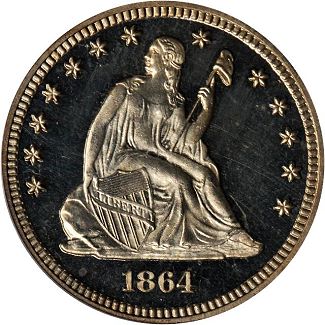 An UHR Saint is a very famous rarity. I will soon write more about Ultra High Reliefs, probably next week. I will then discuss the history of this specific piece.
An UHR Saint is a very famous rarity. I will soon write more about Ultra High Reliefs, probably next week. I will then discuss the history of this specific piece.
The Continental Dollar patterns of 1776 are not in high relief and are made of pewter, which is not similar to gold. Even so, these are also cool items. Members of the Continental Congress considered authorizing such coins, though plans were never well developed. Quite a few dollar patterns struck in pewter survive, along with a much smaller number in silver. These are highly demanded by collectors.
The Continental Dollar pattern is this auction is PCGS graded Extremely Fine-45 and has been approved by the CAC. It is a natural, pleasing, light gray color and is evenly worn. In the few seconds that I examined it, I did not notice any significant problems or other negative issues. It seems excellent for a 45 grade piece of this type.
Ultra High Relief Saints and Continental Dollar pieces are patterns that have historical roots. Pre-1866 ‘With Motto’ patterns of Liberty Seated coins are not as well grounded. Some or all of these may be fantasy pieces that were struck years later than the respective ‘dates’ (years) indicated on the respective pieces. Even so, they are curious and would be entertaining additions to ‘date’ sets of Liberty Seated coins of the same respective denominations.
In this sale, there is an 1864 Liberty Seated Quarter, ‘with motto,’ of the design type that was struck from 1866 to 1891 (except for ‘Arrows’ issues in 1873 and 1874). This 1864 ‘With Motto’ is PCGS certified ‘Proof-66 Deep Cameo.’
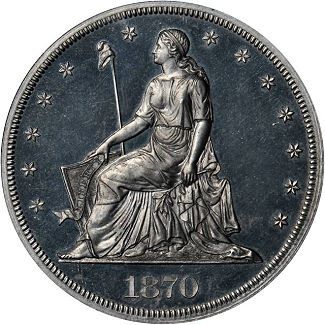 While such pre-1866 ‘With Motto’ Liberty Seated coins ‘look like’ Liberty Seated coins that are dated 1866 or later, other Liberty Seated patterns look quite different from the regular issues. In this sale, there are several patterns, of different denominations, that feature William Barber’s Liberty Seated design. Barber’s concept of a Liberty Seated design is much different from the Sully-Gobrecht-Hughes Liberty Seated designs, which were employed on regular U.S. half dimes, dimes, quarters, halves and silver dollars.
While such pre-1866 ‘With Motto’ Liberty Seated coins ‘look like’ Liberty Seated coins that are dated 1866 or later, other Liberty Seated patterns look quite different from the regular issues. In this sale, there are several patterns, of different denominations, that feature William Barber’s Liberty Seated design. Barber’s concept of a Liberty Seated design is much different from the Sully-Gobrecht-Hughes Liberty Seated designs, which were employed on regular U.S. half dimes, dimes, quarters, halves and silver dollars.
An 1870 pattern half dime, lot #4066, features William Barber’s Liberty Seated design on the obverse and a simple reverse design. It is PCGS certified ‘Proof-65 Cameo’ and is CAC approved. Plus, it was formerly in the Simpson Collection. Unlike regularly issued half dimes, this pattern was struck in aluminum, which was considered, though never used, for regular U.S. coinage.
The following lot is another Barber 1870 half dime, this one with the adopted ‘regular’ reverse design. It is silver, as are all regularly issued half dimes. This Barber 1870 half dime pattern is PCGS certified ‘Proof-66 Cameo’ and is CAC approved.
A highlight of this sale is an 1870 silver dollar pattern that features William Barber’s Liberty Seated design on the obverse (front) and a reverse design that was used for the adopted Liberty Seated issue of the ‘with motto’ type, which was issued from 1866 to 1873. Additionally, this pattern was struck in aluminum. It is PCGS certified ‘Proof-65 Cameo’ and is CAC approved. It is an excellent piece that I would recommend.
The next lot was also struck in aluminum and is another highlight of the sale. It is an 1870 Double Eagle pattern. Double Eagles are $20 gold coins. This piece features the same design as ‘regular’ Double Eagles of the time period. Type Two Liberty Head Double Eagles were struck from 1866 to 1876, and are 90% gold, as are most pre-1934 U.S. gold coins. It is cool to see the same design in aluminum. It is NGC certified ‘Proof-66 Ultra Cameo,’ though, in my view, it should have been certified ‘Proof-65+ Cameo.’ In any event, it is very attractive and very neat. For an aluminum striking, its surface quality is excellent. Aluminum tends to suffer over time.
There are many other patterns in this auction. My point in this passage is to provide a taste of noteworthy patterns with some explanation, as long I am mentioning the Ultra High Relief anyway. There are many patterns of alternative designs. Plus, there are many patterns of silver denominations in copper or aluminum. Patterns of gold denominations were frequently struck in copper and are not that expensive. Learning about patterns may enhance collecting experiences.
II. 1867 Shield Nickels
Typically, regular issue nickels consist of 25% nickel and 75% copper. Although Shield Nickels were minted from 1866 to 1883, those ‘with Rays’ on the reverse (back of the coin) were minted only in 1866 and 1867, a two-year type.
Of all Proof Shield Nickels, the 1867 ‘With Rays’ is the rarest. Fifty to seventy-five 1867 ‘With Rays’ Proofs are known, in all grades. Business strikes of this date, though, are not rare. There are two such Proofs in this auction.
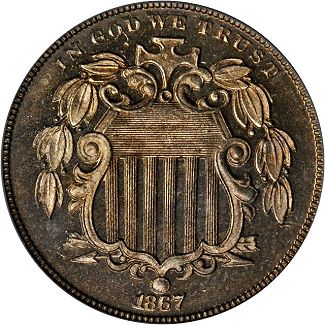 Both are in relatively old PCGS holders, with green labels. On average, though not nearly always, coins in old PCGS holders command a premium over coins in relatively new PCGS holders with standard blue labels. (PCGS Secure labels are a different matter.)
Both are in relatively old PCGS holders, with green labels. On average, though not nearly always, coins in old PCGS holders command a premium over coins in relatively new PCGS holders with standard blue labels. (PCGS Secure labels are a different matter.)
The first of the two is PCGS certified as ‘Proof-66.’ The shield is nicely toned with light russet and blue shades, which are natural. It is definitely a Proof and is an attractive coin overall.
The second is PCGS graded ’65.’ The shield itself exhibits a light cameo contrast. The obverse (front of the coin) by itself would grade 66. There is considerable scuff in the central reverse, however, and I would need to devote more time to examining it to form my opinion regarding the grade of the whole coin. While many collectors assemble sets of Shield Nickels, these are not quite as popular as Liberty Nickels.
III. ‘Land of Smiles’
The lead collector-consignment to this auction is the ‘Land of Smiles’ Collection of Liberty Nickels. “Land of Smiles” is a nickname for Thailand. My impression, from dealers who know him, is that the consignor is a U.S. citizen who is fond of Thailand.
Most of the nickels in the ‘Land of Smiles’ Collection have been certified under the PCGS Secure program. A few are NGC certified.
Those who are unfamiliar with Liberty Nickels may wish to read my two part series on Liberty Nickels, which was recently published on CoinWeek.com. (As always, clickable links are in blue.) Type coins, common dates, key dates, and relative scarcities are explained therein.
The ‘Land of Smiles’ set of business strikes is ranked number one in the PCGS registry, in both the current and “all-time” rosters. According to the formula used in this competition, the ‘Land of Smiles’ set of business strikes has a weighted grade point average of “66.27.” The ‘Land of Smiles’ set of Proofs is ranked second among sets of Proof Liberty Nickels in the PCGS registry.
It is not practical to discuss all of the nickels in the ‘Land of Smiles’ Collection here. I have selected significant 19th century pieces, including several that are major condition rarities.
The ‘Land of Smiles’ PCGS graded “MS-66+” 1883 ‘With Cents’ nickel is CAC approved. It is a great coin that scores extremely high in the category of originality and may have never been dipped. The soft blue and russet tones are unquestionably natural. The cartwheel luster is very pleasing. I recommend this coin.
The 1885 is the key date among business strikes. In relative terms, however, Proof 1885 nickels are not extremely rare in comparison with Proof Liberty Nickels of other dates. I suggest mixing Proofs and business strikes in the same sets. Leading collectors did so throughout much of the 20th century.
I am not thrilled about the ‘Land of Smiles’ PCGS certified ‘Proof-67 Cameo’ 1885. I very much like, though, the PCGS certified ‘Proof-66+ Deep Cameo’ 1885 in this collection. It is mostly ‘black and white,’ with some nice russet toning on the bun and wreath. Its mirrors are full and strong. Some natural scuff in the inner reverse fields and a few small contact marks keep this coin from grading 67. I grade it as 66.7 and I am accepting of the ‘Deep Cameo’ designation. The wonderful nature of this coin is not well conveyed by the catalogue images.
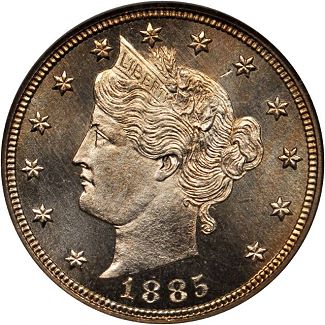 The two 1885 business strikes in the ‘Land of Smiles’ Collection must be mentioned. The first is NGC graded “MS-67” and the NGC has awarded this coin a star for extra eye appeal. It exhibits a subdued brilliance with some cartwheel luster. There are more than a few contact marks in different regions on the coin. Some of these are noticeable near the eleventh and twelfth stars. Plus, a U.S. Mint caused defect near the ninth star is annoying.
The two 1885 business strikes in the ‘Land of Smiles’ Collection must be mentioned. The first is NGC graded “MS-67” and the NGC has awarded this coin a star for extra eye appeal. It exhibits a subdued brilliance with some cartwheel luster. There are more than a few contact marks in different regions on the coin. Some of these are noticeable near the eleventh and twelfth stars. Plus, a U.S. Mint caused defect near the ninth star is annoying.
This 1885 has been dipped more than once, probably several times. There is, though, much, natural light blue toning. There is some scuff on the central reverse, which is often found on old coins. There are some barely noticeable hairlines in the same vicinity. In my view, the grade of this nickel is in the middle of the 66 range. In a technical or aesthetic sense, it does not rise to the 67 level, or even to the 66+ level.
The ‘Land of Smiles,’ PCGS graded “MS-66” 1885 scores higher in technical and originality categories, though it is not a dynamic coin. It is CAC approved. I am not completely comfortable with it.
At the Jan. 2010 FUN Convention in Tampa, an Illinois dealer showed me a PCGS graded ‘MS-66+’ 1885 that is superior to either of the two business strikes in the ‘Land of Smiles’ Collection. That coin remains the best 1885 business strike Liberty Nickel that I have ever seen.
Among business strikes, 1886 Liberty Nickels are also key dates. There are three 1886 nickels in the ‘Land of Smiles’ Collection, one Proof and two business strikes. The PCGS certified, and CAC approved, Proof-67 Cameo 1886 is neat. I am not impressed by the PCGS graded “MS-65” 1886 in this collection, which does not merit a 65 grade.
Really, I prefer the NGC graded MS-65 1886, which is naturally toned, technically strong, and pleasant overall. Some coin enthusiasts and/or professional graders may be bothered by the substantial U.S. Mint caused imperfections on this coin. Some stars are very weakly struck and there are many imperfections in the fields about the stars. These cannot be briefly explained. There are slight imperfections on the face as well. While I would not expect a certified 67 grade Liberty Nickel to have many such imperfections, these are certainly consistent with a MS-65 grade. This is a coin that should be appreciated in actuality. The pleasant, natural toning grabs the viewer’s attention. It is a very appealing coin.
I recommend both the 1887 Liberty Nickels in the ‘Land of Smiles’ Collection. The Proof is PCGS certified ’67 Cameo’ and the business strike is PCGS graded MS-66. Both are CAC approved. These two are excellent coins.
The ‘Land of Smiles’ 1888 business strike is one of the most colorful Liberty Nickels in existence. Although it may bring a startling price in this auction, I am not thrilled by it and I would not recommend it. I strongly prefer the 1890 business strike in this collection.
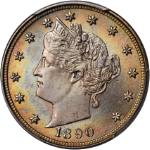 Indeed, the ‘Land of Smiles’ 1890 is terrific. It is PCGS certified MS-66+ and CAC approved. In my view, it grades somewhere between 66.8 and 67.25. It is technically strong with minimal contact marks, very original, and more than very attractive. Moreover, the overall ‘look’ of the coin is enticing. The blue centers are wonderfully balanced by russet outer fields. It is one of the most appealing Liberty Nickels that I have ever seen.
Indeed, the ‘Land of Smiles’ 1890 is terrific. It is PCGS certified MS-66+ and CAC approved. In my view, it grades somewhere between 66.8 and 67.25. It is technically strong with minimal contact marks, very original, and more than very attractive. Moreover, the overall ‘look’ of the coin is enticing. The blue centers are wonderfully balanced by russet outer fields. It is one of the most appealing Liberty Nickels that I have ever seen.
I am impressed by the 1893 that is PCGS certified ‘Proof-67 Cameo’ and is CAC approved. It is technically strong, very cool, really flashy, and more than very attractive.
The ‘Land of Smiles’ 1895 is certainly one of the greatest business strikes in this collection. The natural toning is exceptional. Furthermore, it would be unthinkable for an expert to assign a grade lower than 66 to this coin. I recommend it.
As for the 1897 that is NGC certified ‘Proof-69 Cameo,’ its grade, in my view, is not close to the 69 level. The 1897 that is PCGS certified ‘Proof-67 Deep Cameo’ does truly grade in the middle of the 67 range. I am not in agreement with the PCGS grade of “MS-67” for the 1897 business strike in the ‘Land of Smiles’ Collection.
As for the 1898 Liberty Nickels in this collection, I like all three, two Proofs and one business strike. I am not sure that I would go along with the ’67+’ grade for the first Proof, though a 67 grade is certainly applicable. The PCGS certified ‘Proof-66 Deep Cameo’ 1898 is truly cool, a real prize. The PCGS graded ‘MS-66+’ 1898 is one of the best business strikes in the collection. All three ‘Land of Smiles’ 1898 nickels are CAC approved.
I am not nearly as thrilled with the ‘Land of Smiles’ 1899 Liberty nickels. As for the 20th century Liberty Nickels in the ‘Land of Smiles’ Collection, I will write about them at another time. I hope that I have communicated a fair idea of this collection, and of my opinions of some of the most important coins therein. While I am very disappointed by some pieces, the ‘Land of Smiles’ Collection is exciting overall. I expect very strong prices to be realized for many of the ‘Land of Smiles’ nickels.
IV. Dimes
There are quite a few appealing dimes in this sale. For their respective certified grades, the quality of the dimes in this auction is better than the quality of the half dimes, quarters or silver dollars. For an introduction to dimes, please click to read last week’s column on design types or an earlier column on collecting inexpensive dimes.
The NGC graded MS-62 1796 dime in this auction is truly uncirculated, with no significant friction. It is barred from a higher grade because of a few substantial scratches, including one, small nasty one. After having been lightly to moderately dipped long ago, it has naturally retoned, mostly steel-gray, with much russet. For a collector who is not upset by the scratches, which are not bad, this is an excellent coin for its certified grade. Other certified MS-62 dimes of this type have much more annoying imperfections, in my view.
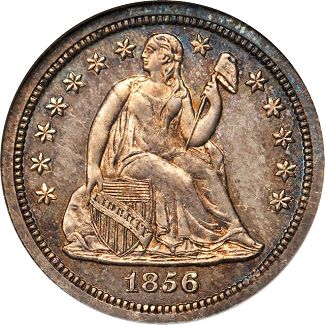 The 1805 Draped Bust, Heraldic Eagle Dime in this sale is PCGS graded AU-50 and is CAC approved. I am attracted to it. The toning is natural and evenly balanced, mostly light gray and mellow brownish-russet.
The 1805 Draped Bust, Heraldic Eagle Dime in this sale is PCGS graded AU-50 and is CAC approved. I am attracted to it. The toning is natural and evenly balanced, mostly light gray and mellow brownish-russet.
The 1827 Capped Bust Dime that is NGC graded MS-67 is not problematic; it is just substantially overgraded. There is a serious scratch on the cheek and numerous hairlines in the left obverse inner fields. The PCGS graded MS-64 1827 is overgraded as well.
The 1828 that is NGC graded Extremely Fine-40 is a much better than average representative of the Capped Bust ‘Large’ type in Extremely Fine grade. Though I do not like the NGC graded MS-64 1832, my guess is that several wholesalers do. It has a ‘commercial look’ that will make it relatively easy to sell to the general public, an awkward dipped white appearance with luster that was stimulated with acid. It may bring a strong price in this auction.
The characteristics of the PCGS certified Proof 1835 dime are complicated. I will discuss this coin in the future.
One of the NGC graded MS-64 1835 dimes in this sale is CAC approved. It is more than attractive. This 1835 was lightly dipped long ago, as were thousands of other 19th century dimes. It has nicely and naturally retoned. Russet shades dominate. While it has a few hairlines, this coin is technically strong overall and is more than attractive. Another NGC graded MS-64 1835 dime just barely ‘makes’ the 64 grade, though it is a nice coin.
A PCGS graded MS-63 Liberty Seated, ‘No Stars’ Dime is a significant type coin, a representative of the first type of the Liberty Seated series. Although I viewed it for just a moment, I tentatively suggest that its grade is in the middle of the 63 range. It has green and russet peripheral tones on a mostly white obverse, and its reverse is rather deeply toned a russet color.
As I recently wrote about the Unrecognized Importance of 1846 Dimes, I cannot resist mentioning the one in this sale, though it has a few technical issues, nothing really serious. I am concerned about some of the contact marks and nearby toning in the upper left inner field on the obverse. A horizontal scratch about Miss Liberty’s neck is bothersome, too. This 1846 is PCGS graded Extremely Fine-40 and is probably okay. Collectors expect circulated coins to have taken some hits during their journeys in commerce.
The Proof 1854 ‘With Arrows’ dime in this sale was previously in the Heritage Platinum Night event of January 4, 2012, in Orlando. I then found that its grade to be in the low end of the 64 range and I reached the same conclusion in June 2012. It is more interesting that this coin just barely qualifies as a Proof, if it does. It could be some kind of non-Proof Special Striking. Most experts, however, would probably regard it as a Proof. It is not a business strike.
This 1854 is deeply and naturally toned. With a lamp, additional colors may be seen on this coin.
The next lot is an 1856 that was previously in the Eliasberg Collection. It has also been recently auctioned, in April 2011, by Heritage.
This Eliasberg 1856 is NGC certified ‘Proof-66.’ While I like the coin, I grade it as 65 or 65+, not 66. It has medium toning, mostly shades of russet, orange-russet, and red. When this coin is tilted under a light, blue and bright orange-russet hues become apparent.
Louis Eliasberg formed the all-time best collection of U.S. coins. This same dime was auctioned in May 1996 in New York by the firm of Bowers & Merena.
Actually, this auction contains two NGC certified Proof 1856 ‘Small Date’ dimes. The second is graded “64.” I viewed it for a few seconds. If the toning is completely natural, its grade is probably in the low end to middle of the 64 range.
In my view, the NGC graded MS-65 1857 dime in this auction should have been graded MS-64. The NGC certified Proof-66 Cameo 1859 has too much of a ‘dipped look’ for my taste. I acknowledge, however, that many qualified dealers would be accepting or even enthusiastic about its 66 grade. There is no doubt that a cameo designation is fair.
The Proof 1862 dime in this auction is not appealing. In my view, it should not have received a numerical grade. I am not sure about my opinions regarding the two PCGS certified Proof 1873 ‘No Arrows’ dimes. I would like to see them again. The remaining Liberty Seated Dimes in this auction are not newsworthy, except maybe the 1876-CC because its reverse is of an unusual variety.
The most newsworthy Barber Dime in this sale is a 1909-D that is PCGS graded MS-66 and is CAC approved. It is a major condition rarity. While technically strong and fairly graded, it is not a dynamic coin. I have seen at least 1909-D dimes of higher quality than this one, though this coin is very important and is among the finest known.
There is a small selection of Mercury Dimes in this sale. A PCGS certified ‘MS-65 Full Bands’ 1925-S will gather some attention. The 1942/1 overdate is very popular with collectors. The 1942/1 in this sale is PCGS graded AU-50 and is CAC approved.
It will be fun to find out the price realized for the Proof 1983 ‘No S’ Roosevelt Dime. It is one of the higher quality representatives of this scarce and popular Mint error. Indeed, this coin and one other 1983-‘No S’ are each NGC certified ‘Proof-70 Ultra Cameo.’ Although I do not accept ’70’ grades, this coin is superb, memorable and cool.
V. Additional Coins
A complete list of noteworthy coins in this sale would be too long to read. There are some really neat Proof Half Dollars. Though I did not see any of the Franklins, my guess is that there will be intense bidding for some very highly certified, business strike Franklin Half Dollars, including a 1951-S that is PCGS graded MS-67. An 1839 Gobrecht Dollar is worth mentioning as these are rare and popular.
There is an extensive run of Proof Liberty Seated Silver Dollars, some of which have appeared in other auctions not long ago. The Anne Kate Collection 1892-S Morgan is important, though I have mixed feelings about it. I would not recommend the Anne Kate Collection 1893-O Morgan in this sale.
The PCGS certified ‘Proof-64 Cameo’ 1895 Morgan is CAC approved. Though I just glanced at it, I found it to be pleasant.
The Dingler 1846 Charlotte Mint Quarter Eagle is a highlight of this auction. There are also a handful of newsworthy Proof gold coins in this sale. The Ultra High Relief towers above all these and, as I said, I will probably write more about it next week.
©2012 Greg Reynolds




